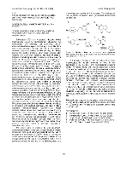Development of antimicrobial agents with activity against drug-resistant bacteria

Publication date
2022Published in
Czech Chemical Society Symposium SeriesVolume / Issue
20 (6)ISBN / ISSN
ISSN: 2336-7202Metadata
Show full item recordCollections
Abstract
Tuberculosis (TB) is a widespread infectious disease predominantly caused by Mycobacterium tuberculosis (M. tuberculosis). The discovery and widespread use of antimicrobials effective against TB starting in the middle of the 20th century allowed a dramatic reduction in TB mortality. However, despite the success of chemotherapy, the disease became the leading infectious killer seven decades later. Recently, the COVID-19 pandemic has reversed years of progress in providing essential TB services and reducing the burden of TB disease. Reduced access to TB diagnosis and treatment has resulted in an increase in TB deaths. The World Health Organization (WHO) estimated 10 million new cases of TB and 1.3 million deaths from TB among HIV-negative people in 2020. Additionally, TB was a contributing factor of approximately 214,000 HIV-related deaths. COVID-19 and TB co-infection is another threat issue, even if some symptoms are identical for both diseases. By 2050, deaths due to antimicrobial resistance are expected to reach 10 million deaths/year if no serious measures are implemented. Among all, Staphylococcus aureus (SA) remains a challenging pathogen that causes common and life-threatening infections of different organ systems. SA is the leading cause of bacteremia, infectious endocarditis, osteomyelitis, as well as being the main causative organism of skin and soft tissue infections, device-related infections, and pleuropulmonary infections, including hospital-acquired pneumonia, ventilator-associated pneumonia, and health care-associated pneumonia SA possess the ability to form biofilms on host tissue or medical implants, which contributes to the persistence nature of chronic SA infections. The current spread of multi-drug resistance is often mentioned in connection with bacterial pathogens, including clinically important methicillin-resistant Staphylococcus aureus (MRSA). MRSA strains have developed resistance to many commonly used antibacterial compounds from different groups, e.g., aminoglycosides, macrolides, fluoroquinolones etc. WHO has declared the antibacterial research against MRSA as one of the priorities. Therefore, there is an urgent need to develop antimicrobial agents with new mechanisms of action or with the ability to overcome resistance of (myco)bacterial strains. The project aims to elucidate the structure-activity-toxicity relationships of the unique, in-house structural types of compounds with good anti(myco)bacterial activity and to elucidate their mechanism of action [1-4]. Based on the obtained results and in silico prediction [5], design and synthesis of new analogs with improved activity and ADMETox profile will be performed and their in vitro and in vivo pharmacokinetic and pharmacodynamic profile will be evaluated. The final goal of this project is to develop novel (pre)clinical antimicrobial candidate(s). Fig.1. Structural types of compounds with significant anti(myco)bacterial activity developed by the authors that will serve as lead compounds in this project. All prepared compounds will be subjected to basic anti(myco)bacterial activity screening in vitro in our established G+/G- bacterial and mycobacterial screening panels. Advanced testing will include static/cidal activity determination, evaluation of the anti(myco)bacterial activity against clinical isolates (including drug-resistant strains), time-kill assays, assays to evaluate the mechanism of action, and screening of antibiofilm activity. Checkerboard studies will be performed to evaluate the potential synergism between candidate compounds and standard anti(myco)bacterial compounds used in clinical practice. Candidate antibacterial compounds will be evaluated in vivo to assess their toxicity and antibacterial activity in the insect model of Galleria mellonella. In the case of potential antiTB agents, the ability of newly developed compound(s) to cure TB will be determined in pharmacokinetically-guided in vivo study in a murine model of TB.
Keywords
antimicrobial agents, drug-resistant bacteria
Permanent link
https://hdl.handle.net/20.500.14178/1704License
Tento výsledek je zpřístupněn v režimu gratis open access, tj. pouze pro čtení. V souladu s § 30 zákona č. 121/2000 Sb., autorského zákona, lze plný text z repozitáře také stáhnout, případně vytisknout, ale pouze pro osobní potřebu.




